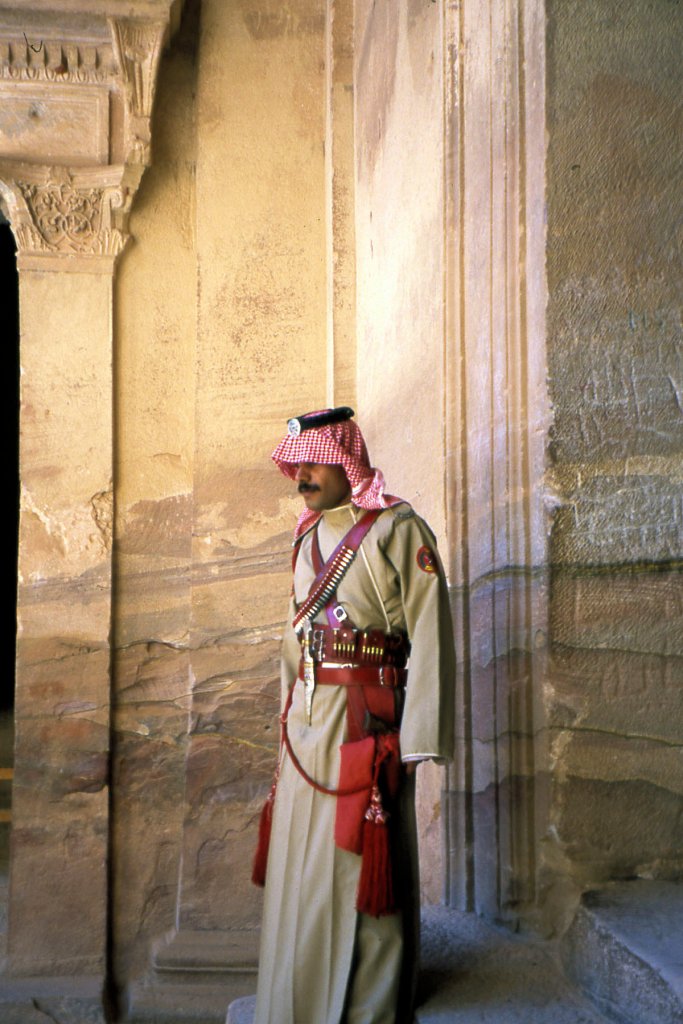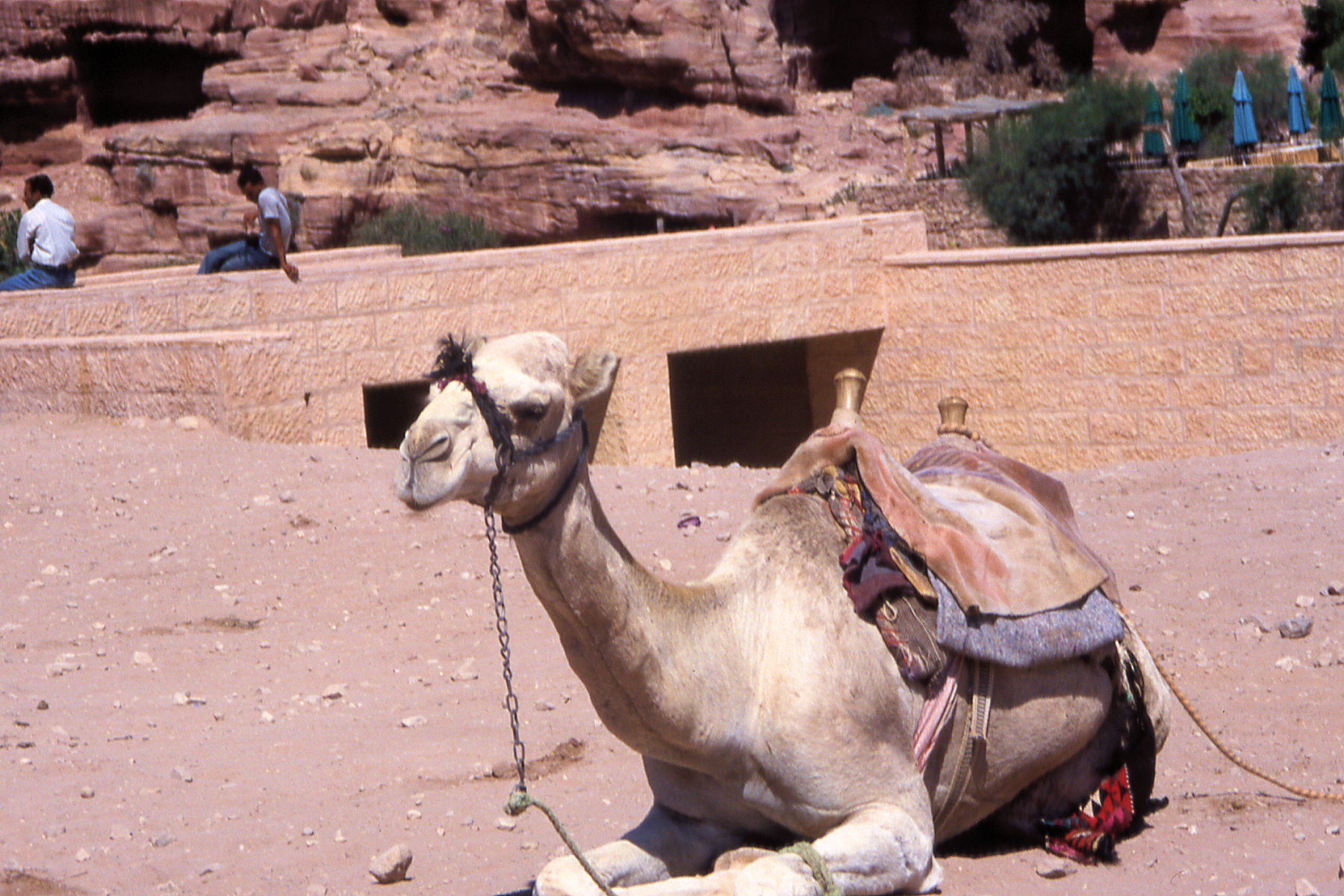The BBC should be showing the marvellous David Lean film Lawrence of Arabia in its new Film Club series on Thursday nights and as always, that film takes me back to my trip to Jordan some years ago, to Petra, Aqaba and Wadi Rum. This is Petra.
Ahmed shines his torch upwards on to the rock-like walls that rise on either side of us to a slit of night sky hundreds of feet above and whispers “Be careful”. I place my feet carefully on the narrow path trodden by ancient tribes centuries ago, a path along which we tourists now travel to view the hidden city of Petra.

Nothing I had read prepared me for my first sight of the fabled Treasury – the most photographed place on the site, a richly deep-hued pink building that had been carved from the mountainside. In the centre of the building was a huge doorway in front of which camels swirled about as their owners petitioned customers to hire their beasts (all guaranteed very tame and ‘no spitting, madam’). In hindsight I think it was good that camels were there to spoil the effect as without them one could well suffer from the Stendhal syndrome (a fainting fit when overcome by the beauty of a place, first recorded by the author in Florence).

In the centre of the doorway stood a Royal Palace guard, resplendent in a long tan-coloured robe liberally bedecked with red bandoliers slung casually over his shoulders the bullets for which were also topped with red, a dagger worn centre stomach, red tasselled sashes and the obligatory red and white chequered kufiyah. I was awestruck.

This was 2012, exactly two centuries after its rediscovery by the explorer Burckhardt, and I was visiting the ‘rose-red city’ of Petra which had lain in ruins for 500 years since its abandonment after the Crusades. Now famous once more due to the work of explorers, painters and film-makers, it still has the power to excite awe and wonder and the approach to it through the narrow gorge is the perfect way to come upon it. Take a guide if you can, chances are he will have been born in one of the caves on the site before the advent of tourism and will have a host of stories to tell you.
Petra’s vast wealth derived from its position as a crossroads of the world where it traded in frankincense from Arabia, spices from India and silks from China. I struggled to imagine caravans of 5,000 camels arriving at this once mighty trading post which Ahmed assured me was the case. How did they negotiate the narrow passages to the entrance? Where did they all live? How did they live? And how did they cope with the smell? Ahmed just smiled. “It is true”, he said, “don’t question, live in the magic”. But it’s not magic; the history books tell me it was so.

Roman Soldiers’ Tombs
Roman Theatre 
Royal Tombs
Away from the Treasury you are in an ancient city of ruined streets lined with Classical façades, a city that housed approximately 30,000 people at its peak, who spoke Aramaic, the language of the Dead Sea Scrolls – in fact, the language of Jesus Christ. Over 80% of the site remains to be excavated and the heaps of rubble you see dotted around were once houses, shops, and communal buildings.





If it’s not too hot (always go early morning if possible) and you have the energy, it is worth climbing the mountain gorge to the High Sacrificial Place, 850 well-cut steps past extraordinary coloured rocks to where there is a façade even larger than that of the Treasury: a doorway and columns 150 feet high. Your reward is breathtaking views over Petra. No one knows for certain what took place here, whether the sacrifices were of animal or human, but evidence of human sacrifices have been found in surrounding towns/cities. Your other reward can be the freshest lemonade with soda you’ll ever have from the very essential café at the top.
Historical bit: The original inhabitants of this 6th-century BC world of temples, Roman theatres, monasteries and chambers, the Nabateans, set up their city-state, defending their home with ease until 106 AD when it fell to the Romans. After the Romans came the Byzantines, then the Crusaders, until by the 16th century Petra was all but lost to the west. A Swiss Explorer, Louis Burckhard, penetrated the hidden city in 1812 and the world became aware of the wondrous city that had once been the centre of a trading empire that stretched from Saudi Arabia to Damascus.
There were few tourists when I visited Petra in 2012 just after the conclusion of one of the many disputes in that part of the world. My guide was fond of saying “We are a small friendly family with some noisy, disruptive neighbours but we welcome visitors” and that was the extent of our political discussion. Now once again I fear there will be few, if any, tourists, and the friendly, welcoming people of the area will miss the tourists. Go visit if you can, when things get better. These friendly people needs and welcomes tourists.

Yes you will. Keep on saying it, it’s what I do even though I know I’ll never get to visit some of the places on my list! Nothing wrong with hoping, or having a dream.
LikeLiked by 1 person
I will get there one day. I will.
LikeLiked by 1 person
As I said in my post, I went at a time when there was soe friction between neighbouring countries and that always puts people off – especially Americans who normally throng to the place on coach tours and cruises. So, choose your time carefully and when you go, arrive early in the morning before the coaches and cruise guests arrive. The temperature is better, the colours wonderful and the atmosphere is magic. But whenever you go, you’ll love it, I know that for a fact!,
LikeLike
I’ve been wanting to go to Petra for sometime now. I’m curious… were there a lot of tourists everywhere? Often I find that famous historical sites have so many tour groups that it’s hard to enjoy the experience. However, your photos suggest that this wasn’t the case!
LikeLiked by 1 person
A fascinating site, especially when taken in the context of the ancient civilization of which it was an important part.
When we made a trip to Egypt years ago and visited Tutankhamun’s tomb, we too were told that the armed guards had the authority to shoot thieves. I wondered then, as I do now, whether the country would really have been prepared to accept the international outrage that such an act would have generated. Fortunately, we never found out!
LikeLiked by 1 person
I never got to see the Tombs, nor in fact, did I ever get to Egypt – a big lack in my travel and cultural experience. One of the museums I would dearly love to see is the Cairo Museum. I’ve seen a TV programme on it and friends rave about it, but just one I’ve missed.
LikeLike
Let’s hope happier times lie ahead when you will be able to make the visit.
LikeLike
Hope you also did Wadi Rum, I’m not sure which one I preferred. I spent a week in Amman which was one of the best times ever. Hope Lawrence of Arabia does make it ot BBC Film Club and also hope it still holds magic. Maybe I shouldn’t watch it.
LikeLike
We were in Jordan in 2010 and its way up there on the list of best places we’ve ever visited. We loved it. And Petra – just amazing.
LikeLiked by 1 person
Thanks, Anabel. I really did find the Jordanians incredibly friendly and welcoming, quite different to the surrounding countries.
LikeLike
I would love to go when it is possible. The entrance passage is amazing and I love the guard whose face is so serene despite all his weaponry. A wonderful post altogether.
LikeLiked by 1 person
Petra is a wonderful place. I will sure visit again. Thanks for beautiful post! 🙂
LikeLiked by 1 person
You are probably a lot closer to it than I am, so I do hope you manage to get there again. It is a very special place.
LikeLike
We visited in 2002 … just before the Iraq invasion, and just about had the place to ourselves. So, we had a one to one (or rather, one to two) personal tour for half a day, after which our guide let us do our own thing, and said he’d meet us in a café later.
I think we must have talked to everyone we met, and learned much.
(Sami, the guide, did an excellent impression of the ‘average tourist’, who gasps in awe an the Kaxneh, takes a picture then scampers back on to the coach to the next attraction! 🙂 )
LikeLiked by 1 person
Yes, having the place to yourself makes a big difference. I stayed near there and split my visit over two days, very early morning one day and then late afternoon the next. I don’t think I could have spent the whole day there, the heat was so intense. I loved the desert though and for some reason, the heat didn’t seem so bad there. Maybe it was the expanse of land all around that kept the stifling feeling at bay.
LikeLike
Awesome photos ..especially the treasury
LikeLiked by 1 person
I’d love to go, Mari, but I feel it’s unlikely. I’ve seen countless photos but I doubt any can match the reality. 🙂 🙂
LikeLiked by 1 person
The biggest drawback is the heat. It really got to me that day and carrying a big bottle of water around all day didn’t help. There is no shade anywhere so once you start to explore you just have to keep on – and then get back.
LikeLike